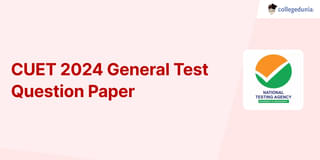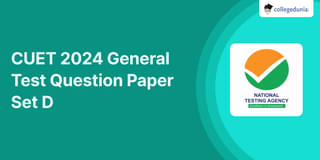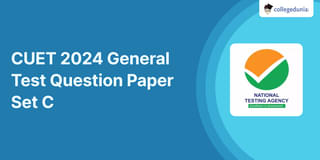
| Updated On - Nov 4, 2024
CUET Physics Question Paper 2024 (Set D) is available here. NTA conducted CUET 2024 Physics paper on 16 May in Shift 2A from 3 PM to 4 PM. CUET Physics Question Paper 2024 is based on objective-type questions (MCQs). Candidates get 60 minutes to solve 40 MCQs out of 50 in CUET 2024 question paper for Physics.
CUET Physics Question Paper 2024 (Set D) PDF Download
| CUET Question Paper PDF | CUET Answer Key PDF | CUET Solution PDF |
|---|---|---|
| Download PDF | Download PDF | To be Uploaded |
















CUET Previous Year Question Paper PDF
| CUET Physics Previous Year Question Papers | CUET Question Paper 2023 |
| CUET Question Paper 2022 | CUET Question Paper 2021 |
Also Check:
CUET Questions
1. In a 600 m race, the ratio of the speeds of two participants A and B is 4:5. If A has a head start of 200 m, then the distance by which A wins is:
- 500 m
- 200 m
- 100 m
- 120 m
2.
A furniture trader deals in tables and chairs. He has Rs. 75,000 to invest and a space to store at most 60 items. A table costs him Rs. 1,500 and a chair costs him Rs. 1,000. The trader earns a profit of Rs. 400 and Rs. 250 on a table and chair, respectively. Assuming that he can sell all the items that he can buy, which of the following is/are true for the above problem:
(A) Let the trader buy \( x \) tables and \( y \) chairs. Let \( Z \) denote the total profit. Thus, the mathematical formulation of the given problem is:
\[
Z = 400x + 250y,
\]
subject to constraints:
\[
x + y \leq 60, \quad 3x + 2y \leq 150, \quad x \geq 0, \quad y \geq 0.
\]
(B) The corner points of the feasible region are (0, 0), (50, 0), (30, 30), and (0, 60).
(C) Maximum profit is Rs. 19,500 when trader purchases 60 chairs only.
(D) Maximum profit is Rs. 20,000 when trader purchases 50 tables only.
Choose the correct answer from the options given below:
A furniture trader deals in tables and chairs. He has Rs. 75,000 to invest and a space to store at most 60 items. A table costs him Rs. 1,500 and a chair costs him Rs. 1,000. The trader earns a profit of Rs. 400 and Rs. 250 on a table and chair, respectively. Assuming that he can sell all the items that he can buy, which of the following is/are true for the above problem:
(A) Let the trader buy \( x \) tables and \( y \) chairs. Let \( Z \) denote the total profit. Thus, the mathematical formulation of the given problem is:
\[ Z = 400x + 250y, \]
subject to constraints:
\[ x + y \leq 60, \quad 3x + 2y \leq 150, \quad x \geq 0, \quad y \geq 0. \]
(B) The corner points of the feasible region are (0, 0), (50, 0), (30, 30), and (0, 60).
(C) Maximum profit is Rs. 19,500 when trader purchases 60 chairs only.
(D) Maximum profit is Rs. 20,000 when trader purchases 50 tables only.
Choose the correct answer from the options given below:
- (A), (B), and (C) only
- (A), (B), and (D) only
- (B) and (C) only
- (B), (C), and (D) only
3. For predicting the straight-line trend in the sales of washing machines (in thousands) on the basis of 8 consecutive years' data, the company calculates 4-year moving averages. If the sales of washing machines for respective years are \( a, b, c, d, e, f, g, \) and \( h \), then which of the following averages will be computed?
(A) \( \frac{a + b + c + d}{4} \)
(B) \( \frac{a + c + d + e}{4} \)
(C) \( \frac{c + d + f + h}{4} \)
(D) \( \frac{b + c + d + e}{4} \)
Choose the correct answer from the options given below:
(A) \( \frac{a + b + c + d}{4} \)
(B) \( \frac{a + c + d + e}{4} \)
(C) \( \frac{c + d + f + h}{4} \)
(D) \( \frac{b + c + d + e}{4} \)
Choose the correct answer from the options given below:
- (A), (B), and (D) only
- (A) and (D) only
- (C) and (D) only
- (B), (C), and (D) only
4. The correct solution of \(-22 < 8x - 6 \leq 26\) is the interval:
- \([-2, 4]\)
- \((-2, 4]\)
- \((-2, 4)\)
- \([-2, 4)\)
5. Match List-I with List-II.List-I List-II (A) Confidence level (I) Percentage of all possible samples that can be expected to include the true population parameter (B) Significance level (III) The probability of making a wrong decision when the null hypothesis is true (C) Confidence interval (II) Range that could be expected to contain the population parameter of interest (D) Standard error (IV) The standard deviation of the sampling distribution of a statistic
Choose the correct answer from the options given below:
| List-I | List-II |
|---|---|
| (A) Confidence level | (I) Percentage of all possible samples that can be expected to include the true population parameter |
| (B) Significance level | (III) The probability of making a wrong decision when the null hypothesis is true |
| (C) Confidence interval | (II) Range that could be expected to contain the population parameter of interest |
| (D) Standard error | (IV) The standard deviation of the sampling distribution of a statistic |
- (A)-(I), (B)-(III), (C)-(II), (D)-(IV)
- (A)-(I), (B)-(III), (C)-(IV), (D)-(II)
- (A)-(I), (B)-(II), (C)-(IV), (D)-(III)
- (A)-(III), (B)-(IV), (C)-(I), (D)-(II)
6. If \( A = \begin{bmatrix} 5 & 1 \\ -2 & 0 \end{bmatrix} \) and \( B^T = \begin{bmatrix} 1 & 10 \\ -2 & -1 \end{bmatrix} \), then the matrix \( AB \) is:
- \( \begin{bmatrix} 1 & 10 \\ -1 & 0 \end{bmatrix} \)
- \( \begin{bmatrix} 15 & -11 \\ -2 & 4 \end{bmatrix} \)
- \( \begin{bmatrix} 3 & 49 \\ -2 & -20 \end{bmatrix} \)
- \( \begin{bmatrix} 1 & 9 \\ -2 & -20 \end{bmatrix} \)










Comments